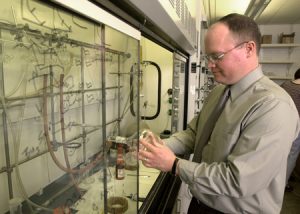
A Denver-based pharmaceutical company focused on dermatology and infectious diseases signed an exclusive licensing agreement with BYU for patented compounds and methods that treat antibiotic-resistant bacterial infections.
Steven S. Porter, chief executive officer of Osmotics Corporation, says his company licensed BYU’s technology because he believes it will address many of the drug-resistant bacteria that cause infections, such as pneumonia, staph infections, and Salmonella.
“There is an increased need for a new antibiotic to combat increased drug resistant bacteria, increased costs of antibiotic therapy, and limited numbers of new antibiotics in the drug-development pipeline,” says Porter. “Additionally, this unique technology may demonstrate antiviral characteristics beyond the antibiotic efficacy for which we are currently testing.”
Clinical testing is now underway to evaluate the compounds for the use in the treatment of gram-negative bacterial infections in burn victims. Approximately 60 percent of the deaths that occur among burn victims are due to uncontrolled bacterial infections.
The newly licensed technology is based on the research of chemistry professor Paul B. Savage, ’88, and has been the subject of more than 10 peer-reviewed journal articles. Extensive in-vitro testing has shown that the BYU compounds are highly effective against multi-drug resistant strains of Pseudomonas aeruginosa, Salmonella, and other potentially lethal bacteria.
“Although the triumph of antibiotics over disease-causing bacteria is one of modern medicine’s greatest success stories, widespread use of antibiotics has led to the development of new strains that are resistant to many antibiotics,” says Savage. “The development of antibiotic resistance makes it more difficult to purge infections from the body and heightens the risk of acquiring infections in a hospital. Consequently, discovery of new antibiotics, especially those unlikely to cause bacterial resistance, is an essential step in controlling the spread of drug-resistant bacteria.”
Most antibiotics target specific bacterial enzymes to inhibit bacterial growth. Enzymes are proteins that control the chemical reactions necessary to sustain life. Over time, bacteria can mutate their enzymatic pathways and become resistant to enzyme-targeting antibiotics. Savage and his colleagues at BYU have modeled their antibiotics after the body’s defense system, which includes antibiotics that destroy bacteria by targeting and destroying their membranes instead of enzymatic pathways. However, unlike the body’s antibiotics, which are relatively large molecules, Savage’s antibiotics are small molecules that are easy to manufacture and purify.
Recent clinical testing has shown efficacy of the compounds against resistant strains of P. aeruginosa obtained from cystic fibrosis patients. P. aeruginosa is a major cause of hospital-acquired infections and tends to infect people with immunodeficiency or burns and those with catheters or on respirators. The bacteria can survive under conditions that few other organisms can tolerate and is resistant to most antibiotics.
Carl Genberg, president of Osmotics Pharma, a division of Osmotics, says he sees this class of antibiotics as a very significant market opportunity for his company.
“Infections caused by drug resistant bacteria can affect anyone—antibiotic resistance is a particularly serious problem for patients with compromised immune systems, like people with HIV/AIDS and patients in critical care units,” says Genberg. “The estimated cost to the health care system of resistant pathogens that require more expensive drug therapy or increased hospital stays is approximately $5 billion.”
Osmotics’ Porter says his company hopes to market an easy-to-manufacture alternative to current antibiotic therapy that will effectively treat a broad range of maladies.






